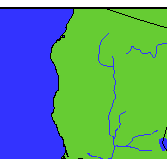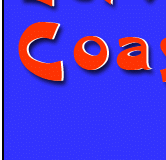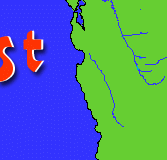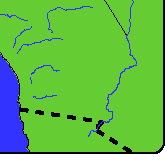|
Precisely
because he's an object lesson in the consequences of war and
of state sponsored violence, the disappearing of McVeigh swiftly
got under way and nowhere is the process more conspicuous
than in the place he should be most vividly remembered.
Drive
through Oklahoma City, as I did in late March, and one is
encouraged to make a detour into downtown, to whose renewal
as a tourist destination McVeigh has made a signal contribution.
From Interstate 40 signs alert travelers to the correct route
to the Oklahoma City National Memorial, the only feature of
the city deemed worthy of such advertisement. The Sunday I
parked my truck next to St. Joseph's church a block away from
the space previously occupied by the Murrah building there
were maybe a couple of hundred visitors in any otherwise entirely
empty downtown. The federal presence is still conspicuous
in the form of the US Courthouse the other side of Fourth
St.
By
any demanding comparative standard the Oklahoma memorial does
not hold up well as a political retort to, or commentary upon
McVeigh's act of murderous demolition. Since the members of
the design committee were clearly disinclined to reflect upon
Why it happened, they settled most determinedly upon the When.
At the east end of the rectangular reflecting pool there's
an bleak modernist portal with 9.01 AM carved on it, this
time check facing, the other end of the pool, a similar portal
featuring 9.03 AM. Along the south side of the pool there's
a lawn with 168 odd-looking chairs with high bronze backs
and plastic seats that light up at night, each with the name
of one of those killed by the bomb. There's a wall to the
next to the east gate featuring the names of all the "survivors"
of the explosion in the Murrah building and adjacent streets
and structures. North of the pool there's a "survivor
tree", an elm felled neither by the blast nor, perhaps
even more strikingly, by Dutch elm disease.
Further
north, the other side of the elm, is the old Journal Record
building, now a memorial center raised by public subscription,
containing public displays, archives and an Institute for
the Prevention of Terrorism. A shop offers mugs, notebooks,
a K-9 poster featuring heroic rescue dogs and other memorabilia.
The
display rooms, filled with the noise of radio and TV commentaries
from the hours immediately following the explosion, resolutely
decline any confrontation with history beyond that of the
"where-was-I-when-it-happened" variety. Words like
"senseless evil" are deployed to do their customary
feeble battle with reality and the past. The superior conduct
of those who work within the civil process is emphasized more
than once, mostly by praising those Oklahomans who espoused
peaceful means to lobby President and Congress in the wake
of the explosion to rush through the Counter-Terrorism and
Effective Death Penalty Act, giving government enhanced powers
to snoop and detain without warrant, and to deny habeas protections
to people on Death Row. The overall emotional tone is one
of intense self satisfaction at the solidarity of Oklahomans
in time of trouble.
And
the perpetrator? I may have missed something, but McVeigh's
role is advertised by just one photograph, the familiar one
of the US Army vet being marched along in orange jumpsuit
and handcuffs by FBI men. You wouldn't know anything about
the man who parked the Ryder truck in front of the Murrah
building, beyond the fact that he was white. You wouldn't
know he was born in Pendleton, near Buffalo, that his father
was a working man, employed by GM, that McVeigh was an okay
student but couldn't get a job in the Reagan recession of
the Eighties that laid waste the old industrial northeast.
He did briefly work as a security guard in a warehouse in
the awful racist, upstate town of Cheektowaga. Decorated veteran
of the Iraqi war? There's no mention, so far as I recall,
of McVeigh's military career. The vexed matter of whether
McVeigh failed physical or psychiatric tests in his effort
to join the Green Berets is similarly undiscussed. I suspect
the US Army put up the failure of a psychiatric test as a
piece of ex post facto justification to show it screens out
dangerous terrorists.
The
photographs of McVeigh outside the Branch Davidian compound
near Waco during the siege are also nowhere to be found, though
they advertise McVeigh's prime stated motivation, to strike
back at the federal government that killed over 80 civilians
including 24 children. Nor, amid the various quotations that
adorn the walls of the Memorial and the pages of the Official
Record, do we find McVeigh's favored quote from Justice Louis
Brandeis: "Our government is the potent, the omnipresent
teacher. For good or ill, it teaches the whole people by its
example. Crime is contagious. If the government becomes a
lawbreaker, it breeds contempt for the law."
There
is a large map of the United States in the exhibit rooms.
You can press a button and be informed of the number of "terrorist"
outrages across a decade, state by state. California offered
me 15, starting with a bombing by the E.L.F. in Davis.
Maybe
there's more about McVeigh in the filing cabinets of the Memorial
Center Archives, or in the Institute for the Prevention of
Terrorism, overseen by a retired state- terrorist, General
Dennis Reimer, former chief of staff of the US Army. According
to the 150-page booklet that is the "official record"
of the bombing, the Institute has two central goals, "to
act as clearing house for information that can help prevent
terrorist acts and to speed rescue efforts when such attacks
do occur".
Maybe
Reimer's staff are preparing new computer maps that will assist
in the prevention of terrorist acts. Perhaps the Center will
furnish a state by state guide as to where the largest clusters
of retired Special Forces veterans and former Green Berets
now reside, many of them time bombs waiting to explode or
already in the process of detonation. Another display could
confront the recent survey establishing that half America's
children acknowledge being in homes with loaded weapons easily
available and then discuss who exactly these gun owners are:
the "gun nuts" feared b y liberals or the millions
upon millions of state sanctioned gun-toters: cops, federal
agents, retired military, and so forth.
Perhaps
political scientists retained by Reimer will scrutinize the
definition of terrorism espoused by the Memorial Center and
taken from the US Code, specifically excluding acts of government
from the "terrorist" designation.
I
had the impression, unverified by any methodical questioning,
that the visitors to the Memorial were unsatisfied by the
displays. They were not absorbed but somewhat aimless and
on the edge of boredom. The Memorial could have offered them
so much more, had its organizers opted to transcend self-congratulation
and banality. How about a weekly drama or even debate in front
of the Survivor Tree about the nature of terrorism, a dissection
of McVeigh's professed motives, a comparison of terrorist
acts around the world, perpetrated by states and by individuals.
Would
not the tourists, some of them retired from the military,
have relished a town meeting on terrorism, where they could
consider such remarks of McVeigh's as (in a 1998 essay): "Hypocrisy
when it comes to the death of children? In Oklahoma City,
it was family convenience that explained the presence of a
daycare center placed between street level and the law enforcement
agencies which occupied the upper floors of the building.
Yet when discussion shifts to Iraq, any daycare center in
a government building instantly becomes 'a shield.' Think
about that. (Actually, there is a difference here. The administration
has admitted to knowledge of the presence of children in or
near Iraqi government buildings, yet they still proceed with
their plans to bomb – saying that they cannot be held
responsible if children die.)"
But
the Memorial's organizers have declined all such avenues of
opportunity. Better to think of the onslaught as a vacuum
between 9.01 and 9.03, as a terrible piece of bad luck when
Mom might not have left her kid off at the child care center
on the second floor, when the HUD secretary on the Fifth Floor
might have taken the day off, might have stepped back a couple
of yards just before the floor fell away. It's American, surely,
to think of the attack in the Midwestern heartland as a matter
involving senselessness and bad luck rather than political
events and historical circumstances.
McVeigh's
American as apple pie too, not least in the media-obsessed
grotesquerie of his (presumptively) final days, trying to
have his "state-assisted suicide" screened on national
TV, wishing he could smuggle out his sperm to female admirers,
planning to cry out "168 to 1" in his final statement.
That's a lousy, evil way to look at the efficacy of political
terror, but after all, look at the outfit that trained him.
Copyright
© 2001 Alexander Cockburn
Please
Support Antiwar.com
Send
contributions to
Antiwar.com
520 S. Murphy Avenue, #202
Sunnyvale, CA 94086
or
Contribute Via our Secure Server
Credit Card Donation Form

Your
Contributions are now Tax-Deductible
|









